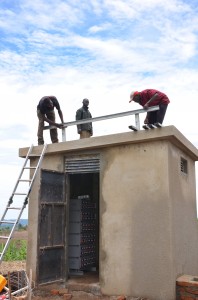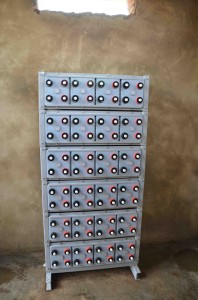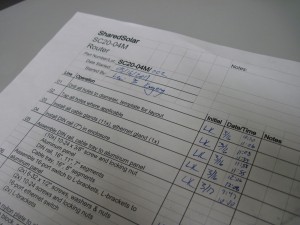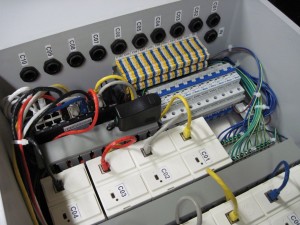As of 7pm tonight, Justin, Harrison & Levi have the first 2 systems ready for shipment. They leave tomorrow morning for Bamako, Mali. Cool stuff. The remaining 22 systems will be on their way shortly. . .
As of 7pm tonight, Justin, Harrison & Levi have the first 2 systems ready for shipment. They leave tomorrow morning for Bamako, Mali. Cool stuff. The remaining 22 systems will be on their way shortly. . .
We were planning to finish the AC side of the shed wiring today (after two days delay, including a trip early Saturday morning), but we encountered yet another delay due to material orders not coming in on time (via the electrical contractor), so we pressed on to the DC side of the shed assembly.
The PV mounting structure was installed, as shown in the picture below. The structure went up very very quickly. I barely had time to click a few pictures before it was up. (I just wish they were as fast at obtaining all the necessary materials for the AC side, as they were at assembling the PV mounting structure!)

The first Uganda installation is coming along nicely (though we’re experiencing typical delays, materials sourcing issues, etc.). Below is a quick sketch of the distribution system. Contractor negotiations (to drive down cost & save time) have been resulting in daily changes to this system. This drawing is two days old and already out-of-date. Life moves fast (or slow depending on your perspective).
Much of the last week has been focused on this distribution system. In the interest of getting a robust system in place quickly, that we can learn from, we have not optimized the cost of this system. Below are pictures of the piping containing the wires (before the pipes were buried).
Though this week we’ve been focusing mainly on the AC side of the system, the batteries were stacked so as to make enough space in the shed for working on the meter this weekend. (Too bad the batteries were stacked incorrectly, meaning re-situating each of the 6, 100kg modules!) Next week we’ll be wiring up the DC side of the system!
 Every day on our drive to this pilot site in Ruhiira we pass two billboards as we leave Mbarara. The first shows the dangers of stealing electricity! (SharedSolar should decrease a consumer’s ability to steal electricity, because of the way the “shed” is designed and the nature of pre-payment.) The second picture is an interesting take on marketing and incentives. Some in some settings beer is marketed with sports cars and models, others with bananas.
Every day on our drive to this pilot site in Ruhiira we pass two billboards as we leave Mbarara. The first shows the dangers of stealing electricity! (SharedSolar should decrease a consumer’s ability to steal electricity, because of the way the “shed” is designed and the nature of pre-payment.) The second picture is an interesting take on marketing and incentives. Some in some settings beer is marketed with sports cars and models, others with bananas.
The amount of equipment and tight deadlines to which we are working requires a level of organization to which some graduate students may not be accustomed. We’ve implemented a manufacturing process adopted from the lean manufacturing world. The most important part in our process is the router document. This document lists top-level, step-by-step directions to completing an enclosure. In order to build a system, a router is printed for every enclosure involved. As a step is completed, the operator signs his or her initials and the date and time at which the step was completed. This router serves two major functions: one, to give the operator a list of instructions and two, to lend accountability and traceability to the build process. At the end of each day, each of us can take the routers we’ve worked on and upload to a shared document the latest step completed and the date and time at which it was completed. This will eventually allow us to see how much time it takes to build each system (hopefully over time this number will improve) and predict the completion dates.

Another component of the process is what we’re calling a “construction document.†In industry, this type of information would be captured in a detailed engineering drawing, assembly drawing, or manufacturing drawing. Since we’re in the business of assembling off-the-shelf components into an enclosure and not building the components themselves, we thought the best way to capture the necessary technical information would be in a document. The construction document contains standard wire lengths, more detailed instructions, and photographs of the building process.
For these first couple systems, the routers have been beneficial in reminding us of the sequence of steps during the process. We hope that further into the big build, they will be more valuable in tracking time-to-build and estimating ship dates.
Here’s the first mass-produced metering enclosure!
